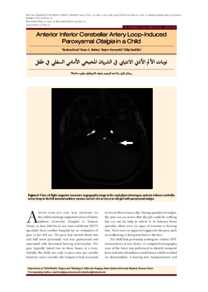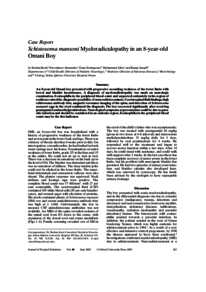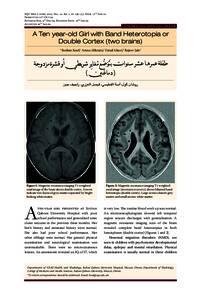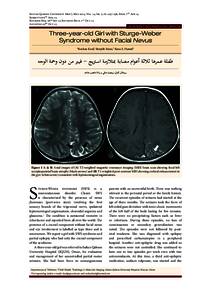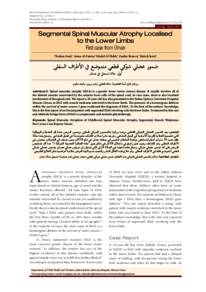Document
Anterior inferior cerebellar artery loop-induced paroxysmal otalgia in a child.
Identifier
DOI: 10.18295/squmj.2015.15.03.023.
Contributors
Other titles
نوبات الألم الأذني الانتيابي في الشريان المخيخي الأمامي السفلي في طفل
Publisher
College of Medicine, Sultan Qaboos University.
Gregorian
2015-08
Language
English
English abstract
A seven-year-old girl was referred to the child neurology outpatient clinic of Sultan Qaboos University Hospital in Muscat, Oman, in June 2014 by an ear, nose and throat (ENT) specialist from another hospital for an evaluation of pain in her left ear. The pain had started about two and half years previously and was paroxysmal and associated with decreased hearing and tinnitus. The pain typically lasted two to three hours at a time. Initially, the child was only in pain once per month; however, more recently, the frequency had increased to two to three times a day. During episodes of otalgia, the pain was so severe that the girl could do nothing but cry out for help to relieve it. In between these episodes, there were no signs of tinnitus or hearing loss. There were no apparent triggers for the pain, such as swallowing or being touched on the face. The child was referred to a neurosurgeon for consultation and potential decompression. She was also started on gabapentin. This was prescribed initially as a nightly dose of 25 mg which was increased twice weekly to a maximum nightly dose of 100 mg. Conservative management (500 mg of paracetamol) was recommended for relief of the frequency and severity of her ear pain. A follow-up examination indicated an improvement of approximately 50% in the level of pain. triggers pain due to the intermediate nerve, while pain when swallowing is due to the ninth nerve. However, no such triggers were observed for the current patient. An MRI scan revealed that an arterial loop of the AICA was compressing the seventh nerve. Neurosurgical decompression is the definitive treatment for this condition.
Member of
Resource URL
Citation
Koul, Roshan, Rahim, Rana A., Kariyattil, Rajeev, & Sankhla, Dilip (2015). Anterior Inferior Cerebellar Artery Loop-Induced Paroxysmal Otalgia in a Child. Sultan Qaboos University Medical Journal, 15 (3), 438–439.
Arabic abstract
تمت إحالة فتاة تبلغ من العمر سبع سنوات إلى العيادة الخارجية لطب أعصاب الأطفال في مستشفى جامعة السلطان قابوس في مسقط ، عمان ، في يونيو 2014 من قبل أخصائي الأذن والأنف والحنجرة (ENT) من مستشفى آخر لتقييم الألم في أذنها الأيسر. بدأ الألم قبل حوالي عامين ونصف وكان نوبات انتيابية ومرتبط بنقص السمع وطنين الأذن. يستمر الألم عادة من ساعتين إلى ثلاث ساعات في كل مرة. في البداية ، كان الطفل يعاني من الألم مرة واحدة في الشهر ؛ ومع ذلك ، في الآونة الأخيرة ، زاد التردد من مرتين إلى ثلاث مرات في اليوم. خلال نوبات ألم الأذن ، كان الألم شديدًا لدرجة أن الفتاة لم تستطع فعل أي شيء سوى الصراخ طلبًا للمساعدة في تخفيفها. بين هذه النوبات ، لم تكن هناك علامات على طنين الأذن أو فقدان السمع. لم تكن هناك مسببات واضحة للألم ، مثل البلع أو لمس الوجه. تمت إحالة الطفل إلى جراح أعصاب للاستشارة وإمكانية تخفيف الضغط. كما أنها بدأت في تناول جابابنتين. تم وصف هذا في البداية كجرعة ليلية مقدارها 25 مجم والتي تمت زيادتها مرتين أسبوعياً إلى جرعة ليلية قصوى تبلغ 100 مجم. أوصت المعالجة التحفظية (500 مجم من الباراسيتامول) للتخفيف من وتيرة وشدة آلام أذنها. أظهر فحص المتابعة تحسنًا بنسبة 50٪ تقريبًا في مستوى الألم. يسبب الألم بسبب العصب المتوسط ، بينما الألم عند البلع ناتج عن العصب التاسع. ومع ذلك ، لم يلاحظ أي محفزات للمريض الحالي. كشف فحص التصوير بالرنين المغناطيسي أن حلقة شريانية من AICA كانت تضغط على العصب السابع. تخفيف الضغط عن طريق جراحة الأعصاب هو العلاج النهائي لهذه الحالة.
Category
Journal articles

